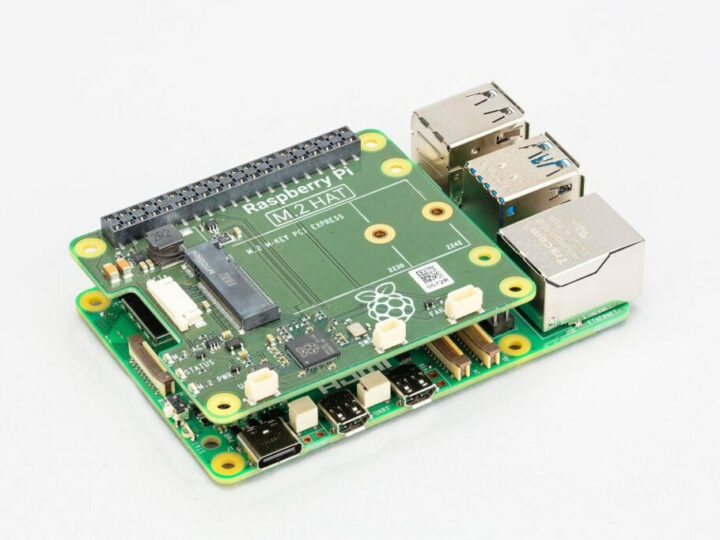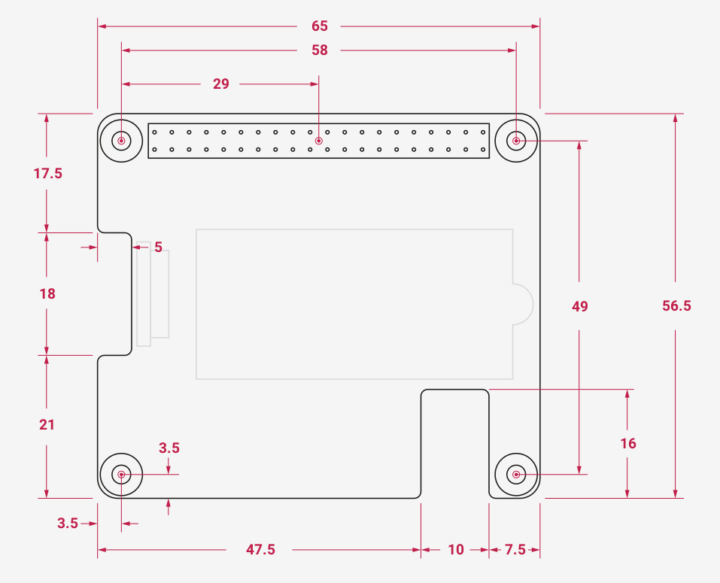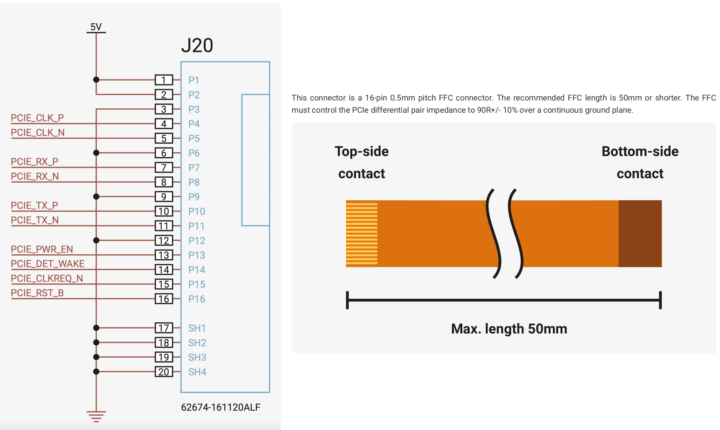Raspberry Pi has released two new specifications one for the PCIe FFC connector and related cable and the other for the new Raspberry Pi HAT+ (HAT Plus) standard that’s simpler, takes into account new features in Raspberry Pi 4/5, and has fewer rules around mechanical dimensions.
PCIe FFC connector specifications
The Raspberry Pi 5 was announced over 2 months ago with a new PCIe FFC connector, and people may been playing around with it and even launching products such as an M.2 HAT for the Raspberry Pi 5 since then even though the pinout and specifications were not available. But Raspberry Pi has now released the specifications (PDF) for the PCIe FFC found in the Raspberry Pi 5 and likely future models as well.
The 16-pin 0.5mm pitch FFC connector features a single lane PCIe interface, something we knew already, but the pinout diagram and recommendations for the FFC cable (up to 50mm in length with controlled impedance to 90R+/- 10%) have now been made available as well. The PCIe interface is re-confirmed to be PCIe Gen 2 in the specs and the announcement, although Jeff Geerling managed to change settings to enable PCIe Gen 3.
Raspberry Pi HAT+ standard
The Hardware on Top (HAT) standard for expansion boards connected on top of the Raspberry Pi SBC was introduced in 2014, and Raspberry Pi just announced that the original HAT specification is now deprecated, and replaced with the HAT+ specification (PDF) although this is still preliminary.
The main changes with the HAT+ specification are:
- HAT+ boards must be electrically compatible with the STANDBY power state, where the 5V power rail is powered, but the 3.3V rail is unpowered. Note: Raspberry Pi 4 and Raspberry Pi 5 support the STANDBY state, while older Raspberry Pi models do not.
- The specification is less prescriptive about HAT physical dimensions.
- The HAT EEPROM content is now much simpler.
- A special class of HAT+s that can be stacked with an extra HAT+ on top is supported for a maximum stack of two HATs.
- HAT+ boards are electrically backwards-compatible with older Raspberry Pi models, but may need up-to-date software and firmware to function correctly.
The first one may be important to power consumption in power off mode. Let me explain. The Raspberry Pi boards now support two standby modes:
- WARM-STANDBY – The Raspberry Pi is halted/off, but all of the power rails are still enabled. This is the default mode when doing a sudo halt or soft power-button-off operation.
- STANDBY – The Raspberry Pi has the 5V rail powered — so the power management chip is powered — but no other power supplies on the PMIC and board are enabled. You can configure sudo halt or power-button-off using the EEPROM to enter this mode instead of WARM-STANDBY.
WARM-STANDBY is the default in Raspberry Pi OS so both 5V and 3.3V are enabled and that’s why I measured a 1.7W power consumption for the Raspberry Pi 5 when it is powered off… We can change /boot/config.txt (POWER_OFF_ON_HALT=1, WAKE_ON_GPIO=0) to bring that down to about zero as found in the documentation and tested by Jeff Geerling. So why it’s not enabled by default? That’s because some HATs require both 5V and 3.3V. But the new HAT+ add-on boards will have to work with the STANDBY mode at 5V only.
What does “less prescriptive HAT dimensions” mean exactly? That’s pretty simple: a HAT+ board only needs to connect to the 40-way GPIO header (including the ID_* pins), and to have at least one mechanical mounting hole align with one of the four Raspberry Pi mounting holes, and that’s about it which should allow for more form factors. You’re also asked not to mess with access to other connectors and the Raspberry Pi 5 Active cooler…


One reason the just released HAT+ specification is still preliminary is that the EEPROM utilities have yet to be updated for the new, simpler EEPROM parameters. The final version of the specification along with the official M.2 HAT+ board will be released next year.

Jean-Luc started CNX Software in 2010 as a part-time endeavor, before quitting his job as a software engineering manager, and starting to write daily news, and reviews full time later in 2011.
Support CNX Software! Donate via cryptocurrencies, become a Patron on Patreon, or purchase goods on Amazon or Aliexpress





